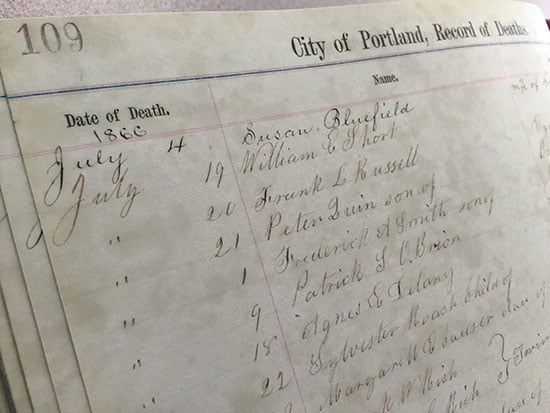150 Years Later, Death Toll Revealed
The death toll from Portland’s Great Fire of 1866 was surprisingly small given the descriptions of flames sweeping across the peninsula and the sheer scale of the disaster: one-third of the city destroyed and more than 10,000 people were rendered homeless.
However, exactly how many people perished in the disaster has been an unresolved question for one and a half centuries.
Reports at the time – and historical accounts well afterward – were vague and contradictory. Some accounts included a death toll of two people, while others said no one died.

Portland’s original death records include a reference to Susan Bluefield, who died at age 36 in the fire. Photo by Randy Billings.
The Portland Press Herald/Maine Sunday Telegram analyzed the city’s original death records in an effort to find out exactly how many people died and who they were. The newspaper confirmed four deaths attributed to the July 4, 1866 fire, including a 74-year-old man who died months after being severely burned.
The chaos and unconfirmed eyewitness accounts clearly contributed to the confusion about the death toll.
The July 10 edition of the Eastern Argus reported that three intoxicated men were believed to have been burned to death in the Portland Sugar House, which was one of the first buildings to be burned. However, it also reported that “only one death is known to have occurred, and that was of an infant which was thrown from a two-story window by its frantic mother. A man below failed to catch the little one and its brains were dashed out on the pavement. The mother jumped afterward and... was caught uninjured.” The Argus also reported that “Zebelon Chickering and wife” were exhumed, but even though “they had been missing since the fire it has not been supposed they perished in the flames.”
Meanwhile, the Portland Transcript published conflicting information in its own news pages on July 14.
The news section reported that “there was no loss of life. There were numerous reports of lives lost but none of them were easily authenticated,” including the baby thrown from the second-story window, which it attributed to the Boston Journal.
However, a special insert in that same edition, called “Burning of Portland: A Full Account of the Great Conflagration in Portland, July 4th, 1866,” reported that “Sabin Chickering and his mother” were removed from their Washington Avenue home days after the fire, but never attributed the cause of death as being the fire. It also reported that a 74-year-old man was severely burned and was in “languishing condition.” Others were burned, but apparently not severely, or missing, the paper reported.
The City of Portland Directory from 1869, which contains detailed information about the city, its economy and its people, declared that “no one (was) killed, no one injured” in the Great Fire.
In an attempt to resolve the mystery, the Portland Press Herald/Maine Sunday Telegram examined the city’s death records from that year. The records are kept in large, bound books bearing the script of the clerk who originally entered the information. The city required rubber gloves be worn by anyone touching the pages to avoid damaging the city’s original vital records.
Among the dead was Susan Bluefield, 36, who died on July 4, with the cause being listed as “burned to death.” However, the death appears to have been added to the record 25 years after the fire. Her name is squeezed into the same ledger as another death, with the following note that was apparently added on Feb. 11, 1891: “Her body was entirely consumed in the house in which she lived on Fore St. Affidavit of... G. Webster and Elizabeth J. Webster.”
The city’s “Record of Burials, Vol. 6A, 1862-1866” indicates that Bluefield is buried in Eastern Cemetery, but the city said there is no record or headstone for her.
Samuel Soule, 74, was badly burned on the hands and face and reportedly inhaled the flames, according to one account. He died on Sept. 6 as a result of those burns, the city’s death records show. His official cause of death is listed as “burned July 4th.”
Soule was a joiner who lived at 7 Quincy St. He is buried in Evergreen Cemetery. He does not have a headstone, but his wife, Julia Soule, does.
One of the most baffling mysteries is that of the Chickerings. Was it a husband and wife, as reported in one newspaper? Son and mother, as reported elsewhere?
The answer is neither.
The city’s death records for July 5 list “Zabrina Chickering and her mother” on the same ledger. The cause of death is “burned.” Their ages at the time are unknown. They are buried in the Stranger’s Lot in Forest City Cemetery, a section in the Portland-owned burial ground located in South Portland for poor people.
“Burial Records, 1717-1962 of the Eastern Cemetery,” compiled by William Jordan Jr. and published in 1987, listed the mother’s name as Elizabeth.
And what of the baby thrown out of a burning building?
City records do not list any infant deaths for July 4 or 5.
Legacy Seared into History
150 Years Later, Death Toll Revealed
One of the disaster’s lingering mysteries is laid to rest when the Portland Press Herald/Maine Sunday Telegram examines Portland’s original death records.
MoreFire's Lasting Impact Both National and Local
The Great Fire leads to national standards for assessing fire risk, and it forges the city that survives to this day.
More
Tell your friends